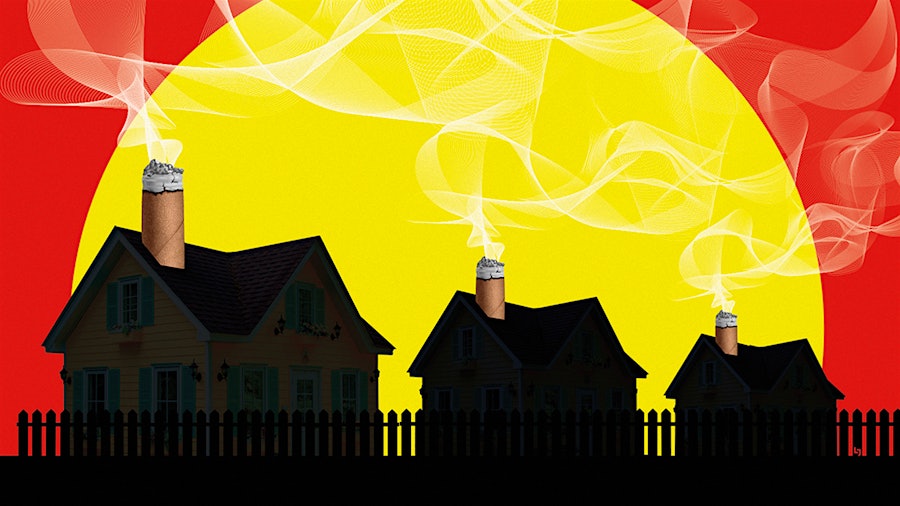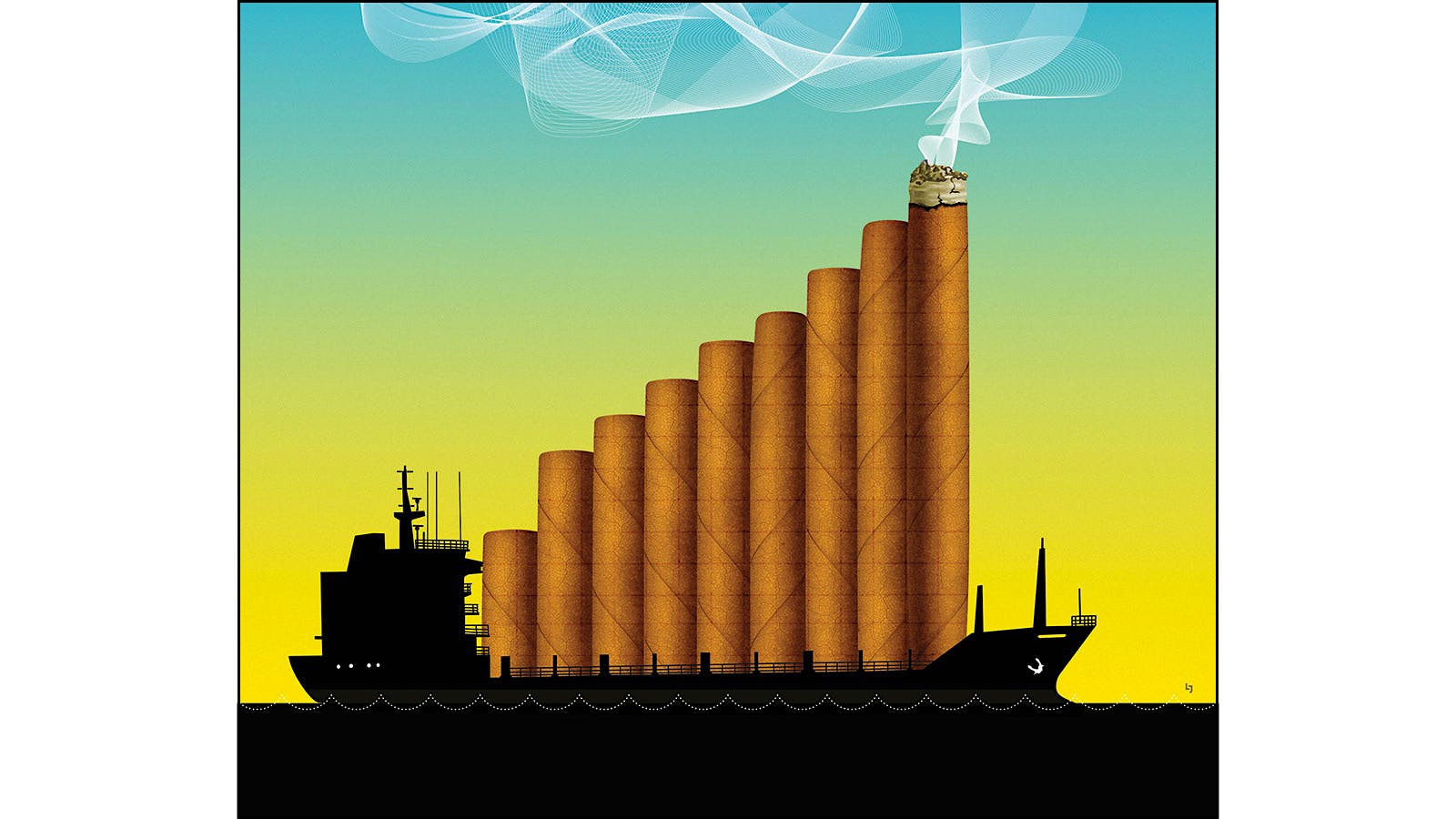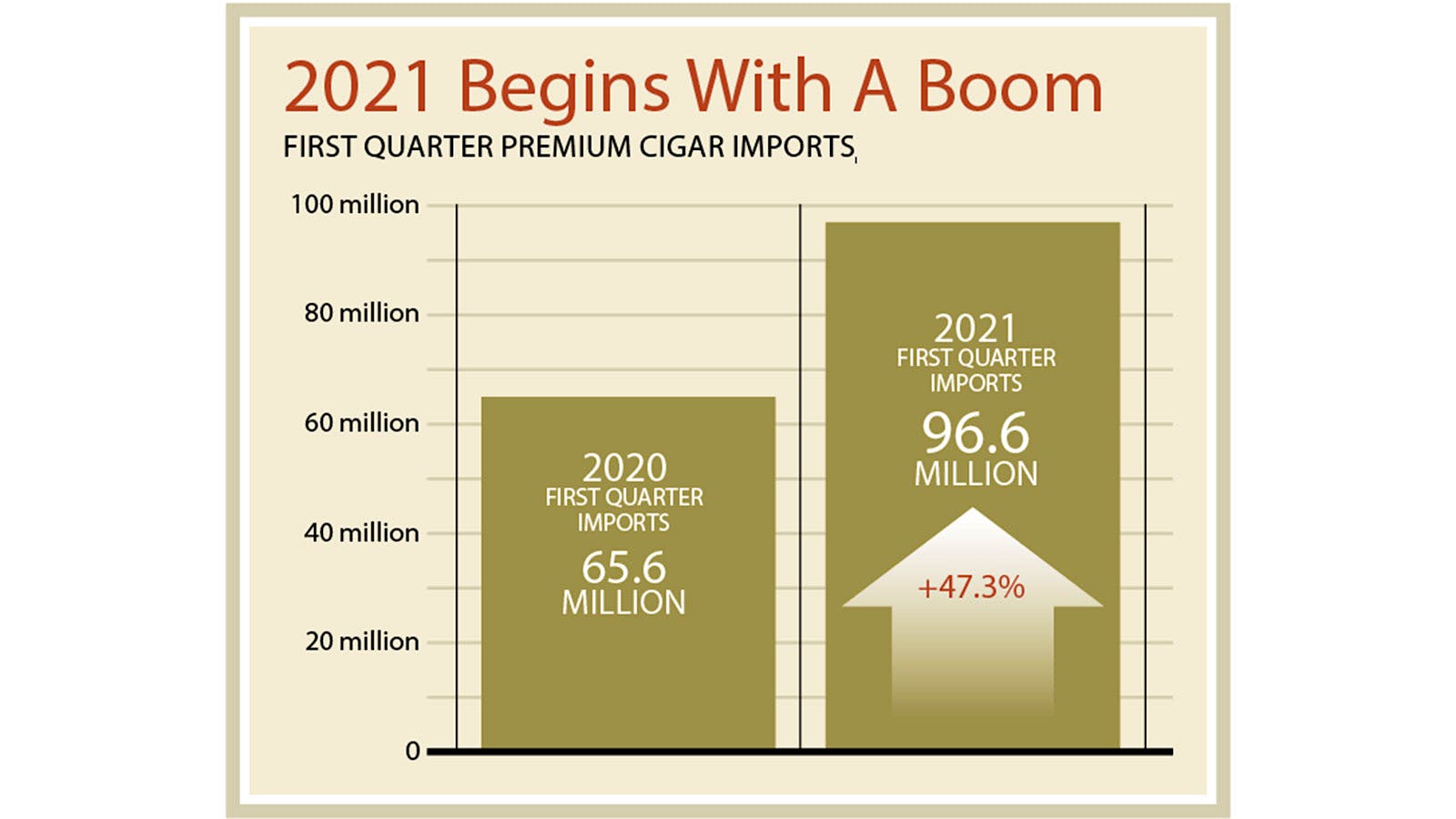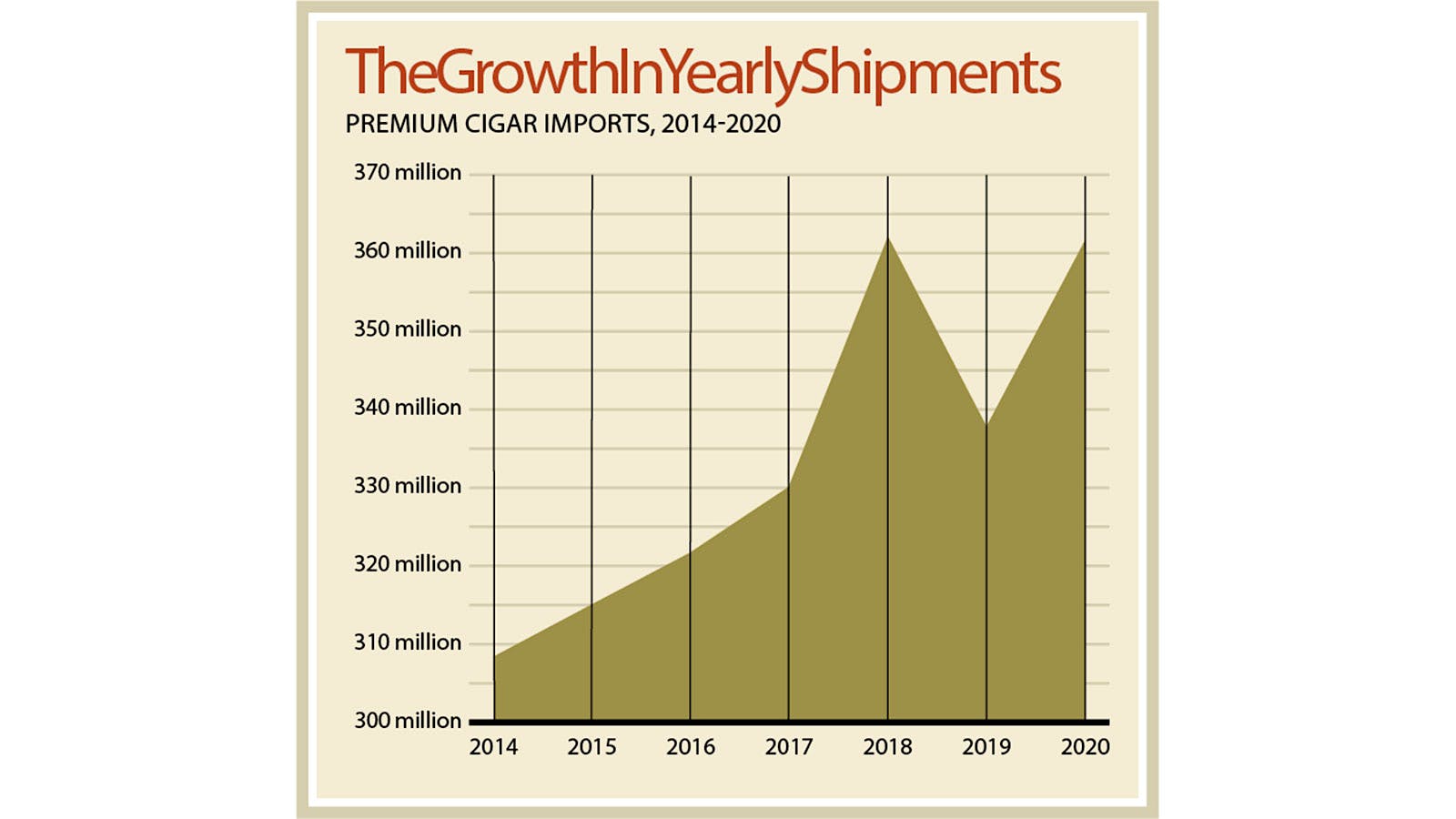The New Cigar Boom

Even in most dire of economic conditions, there are always a few industries that not only manage to survive, but actually flourish. Some markets are truly recession proof—usually essential commodities or inexpensive goods—but when in history has an ailing economy seen an increase in the consumption of luxury products? The answer is right now.
It seems a contradiction, but in 2020, when most of America shut down for business, the handmade cigar market experienced an increase in demand, with exports up seven percent. That growth has accelerated into 2021, with double-digit gains and no signs of slowing. Imports are soaring, cigars are being depleted from humidors and cigarmakers are busy making product at a level last seen during the cigar boom of the 1990s.
Few expected this to happen. Exports of handmade, premium cigars to the United States were steadily rising before the pandemic, and shipments experienced a slight dip in 2019. Then came 2020. Stricken by the Covid-19 outbreak, much of the world went into lockdown starting in March, which meant a certain number of catastrophes for the premium cigar industry: cigar shops across the U.S. either operated at a reduced capacity or closed completely; many cigar factories were forced to temporarily shut down, particularly in Honduras and the Dominican Republic; and supply chains were stalled as logistics came to a near standstill.
All signs pointed to a long and severe cigar recession, but in September, the industry sprang back to life. Like a lagging thoroughbred that pulls ahead at the last minute, premium cigar imports started to soar. In September, imports rose 46 percent over 2019 numbers, and October and November both showed 27 percent gains. Then came December, with a staggering increase of more than 70 percent.
The robust end to the year caused 2020 shipments to end up seven percent higher than 2019. A total of 361.3 million premium cigars were imported into the U.S., essentially equal to 2018, the best year for the cigar industry since 1997.
That superb fourth-quarter 2020 performance continued into the new year. Imports for January 2021 rose by 55 percent, then 42 percent in February and 47 percent in March. The entire first quarter of 2021 was up 47.3 percent over the previous year, and one would expect those numbers to continue to show improvement, as the effects of the pandemic didn’t begin to truly manifest until the second quarter of 2020.
“The industry as a whole is booming,” says Ernesto Perez-Carrillo, who’s been in the business for more than 50 years. “I think it has to do with cigar smokers working at home more.” His sales so far in 2021 are up 122 percent, and he makes a portfolio of brands in the Dominican Republic, which include the E.P. Carrillo Pledge Prequel, Cigar Aficionado’s Cigar of the Year.
Much of the increase in sales—especially in the darkest days of 2020, when many retail establishments were shuttered—came from Internet or catalog sales, rather than brick-and-mortar shops. “I have been in the industry for 18 years and have never seen the exponential growth and market share increases we’ve seen over the last year,” says Sarah Santos, president and senior vice president of Scandinavian Tobacco Group’s North America online and retail division.
Scandinavian not only owns General Cigar Co., which produces premium brands such as Macanudo and CAO, but two leading online and catalog cigar retailers: Thompson Cigars and Cigars International, which sells just about every cigar brand one can imagine. Business is so strong at Cigars International that the company broke ground in May on a massive expansion at its headquarters in the tax-friendly town of Bethlehem, Pennsylvania. Construction is now well underway, and will add an extra 100,00 square feet to its already huge warehouse. By the end of the year, the company should have a sprawling 213,500 square-foot facility up and running, larger than a typical Sam’s Club or Costco superstore.
Santos says 2020 sales were up in the “solid double digits” at Cigars International, with no signs of slowing. “Our sales show that discretionary spending on cigars accelerated during the pandemic,” she says, “and buying trends predict this buoyancy will continue in 2021.”
Drew Newman is a fourth-generation owner of the 126-year-old J.C. Newman Cigar Co., and he gives a bit of historical perspective. “The American premium cigar industry experiences a boom every 25 years,” he offers. “Demand surged during the Roaring Twenties. The U.S. government artificially increased demand by buying all available cigars during World War II. Sales [also] spiked in the late 1960s. When he founded Cigar Aficionado magazine in 1992, Marvin Shanken triggered the last cigar boom. Twenty-five years later, the American premium cigar industry is in the midst of a cigar boom once again.”
Newman has seen a significant increase in demand lately for his company’s premium cigars—which include Diamond Crown and Brick House—but he’s careful to not romanticize these fleeting periods of high demand. “The truth is that booms are very challenging times for cigar makers. Because premium cigars are natural, agricultural products that are handcrafted, it is extraordinarily difficult to rapidly increase or decrease production. Since we age tobacco for a minimum of three years, we plan our production well in advance. You simply cannot shortchange the time it takes to naturally ferment and age premium cigar tobacco.”
One company that may have been ready for this surge in sales has been Tabacalera USA—the behemoth of the premium cigar industry. Through its Fort Lauderdale, Florida, subsidiary Altadis U.S.A., Tabacalera produces and distributes the non-Cuban versions of Romeo y Julieta, Montecristo and H. Upmann. It also owns catalog/online cigar giant JR Cigars.
“During 2020 and the first five months of 2021, JR’s sales increased significantly due to the sales restrictions of the pandemic,” says Javier Estades, president and CEO of Tabacalera USA. With many retailers closed, some smokers had no choice but to turn to the Internet. “The pandemic circumstances contributed to a significant growth in consumption of premium cigars. Many adult consumers spent more time at home, which permitted them to enjoy more cigars and we believe some [new] adult consumers joined the category.”
Tabacalera owns two cigar factories, one in the Dominican Republic and one in Honduras. Production at both is at maximum capacity, says Estades. And while few could have predicted that such a devasting pandemic would result in a huge uptick in sales, the company had already been poised for growth. “Given our significant size and financial position, we always keep a very large inventory of cigars at our factories and distribution centers, which enabled us to serve the increased demand.”
Joya de Nicaragua, Nicaragua’s oldest producer of handmade cigars, has gone through more than one boom. “We are definitely experiencing an atypical demand for premium cigars worldwide,” says Juan Ignacio Martínez of Joya de Nicaragua. “Online has without a doubt, driven a great deal of the growth,” he says. “I can assure you that online business took a completely new relevance, not only for cigars, but for nearly everything. I personally think that 2020 has been a tipping point for ecommerce in our industry. Even traditional brick-and-mortar had to move to some form of online commerce to service their cigar communities.”
Many successful cigar retailers have evolved their business models to a hybrid, with both a physical store (or stores) and a large online presence. One proprietor who has both is Florida retailer Jeff Borysiewicz, owner of Corona Cigars. He does business in a state whose governor has been vocally defiant of Covid restrictions and economic lockdowns throughout the pandemic. “Our business was up double digits because we are well diversified with mail order/Internet sales, retail stores and bar sales,” he says, though things lagged a bit for some of his shops. “We were up at some two locations and down at two. The downtown Orlando store took a hit during the shutdown because not many people live downtown and people were working from home. Overall, our retail brick-and-mortar was up single digits.”
David Garofolo of Two Guys Smoke Shop has a similar business model. He owns three shops in New Hampshire and there are no doubts in his mind that we’re in a boom. Things looked grim for his business at the beginning of the pandemic, but they’ve been beyond robust since.
“Where I thought we could never recover from that major drop, we completely recovered in just two months, and then some,” Garofolo says. “We finished the year 2020 with a growth of 51 percent in our retail shops from the previous year. Online, we finished 2020 with a growth of 46 percent. It’s the biggest single growth in our company history since 1985.”
While Internet sales are clearly leading the way, there is also good news from cigar shops. In Virginia, for example, sales are up for all five of the Havana Connections stores, large brick-and-mortar shops located mostly in the Richmond area. Operations manager Jason Cannata wouldn’t say exactly how high, but confirmed that the gains were notable. “Sales are up at all of our stores,” he says. “Cigars turned out to be a simple pleasure that smokers could enjoy at home. Hence our business started growing at a better rate than normal during the pandemic. Now with the increased consumption, we are continuing to grow.”
Back orders, he says, are worse than ever. “Increased demand, manpower issues in the factories and as of late, issues with shipping product into the U.S. has caused massive shortages. As any good retailer will do, we strive to manage the backorders as best we can and are ready with alternative recommendations if your favorite smoke is unavailable.”
Back orders are a downside reminiscent of the 1990s cigar boom days: difficulties meeting demand. Sunken deep in a leather chair at Matador Cigars, a premier brick-and-mortar shop in Long Island, New York, a customer finishes up a Rocky Patel cigar. The shop is busy for a Wednesday evening and despite everyone fixed on the hockey game being shown on multiple televisions, this particular cigar fan is more interested in lighting up his next smoke. He says he enjoys many different brands, and treats himself to a La Flor Dominicana Andalusian Bull on Fridays. That is, when he can find them.
“They were supposed to hold a box for me here, but they sold all the boxes as soon as they came in. There was a misunderstanding” he says, shaking his head while slowly toasting the foot of his new cigar, one made by the Plasencias. “You just can’t find them anywhere now.”
He’s more on point than he knows. The Andalusian Bull has been on back order since it was named Cigar Aficionado’s 2016 Cigar of the Year, the industry’s highest accolade, but with the new boom in sales, the backorder for the Bulls is even worse.
“It definitely feels like we are experiencing another boom,” says Litto Gomez, who makes La Flor Dominicanas at his relatively small factory in the Dominican Republic. “There is more demand, and our incoming orders have grown to unusual levels but due to the production constraints and safety measures we had to implement as a result of Covid, our sales have not increased. We currently have twice as many cigars on backorder as we did on this day last year.”
Jorge Padrón of Padrón Cigars Inc. also refuses to increase production just because demand has grown. For him, maintaining quality control is far more important, even if it means he’s perpetually backordered.
“There was a similar situation in the ’90s and we did not rush production then either to meet demand,” Padrón says, remembering the previous boom. “We’ve never caught up to demand, no matter the time. We try to keep up but never sacrifice the quality of our production just to meet high demand.” His brands such as the Padrón 1964 Anniversary Series, 1926 Serie and Family Reserve are made in Nicaragua and are consistently at the top of Cigar Aficionado ratings.
“The business is strong,” Padrón confirms. “And we’ve always put a huge emphasis on brick-and-mortar. We’re committed to keeping product flowing to them as much as possible.”
With so many more cigars being shipped, tobacco growers like Nestor Andrés Plasencia have undoubtedly felt the increase in demand. He and his family are one of the largest producers of premium tobacco in the business, with vast acreage throughout Nicaragua and Honduras. If you smoke premium cigars, you’ve probably smoked some of his leaf, as his clients are numerous. He also produces brands of his own.
“I don’t know about a boom like in the early ’90s but I do know more people are enjoying cigars and more often,” Plasencia says, fresh from a visit to one of his many tobacco fields in Estelí, Nicaragua. He says his sales are up more than 50 percent from May of 2020. “The term that I have started to hear is a ‘miniboom.’ We are selling more tobacco this year because all of our clients are asking for more and also because we had been increasing our areas of growing tobacco in the previous years.”
Whether this is a full-on boom or “miniboom” as he put it, Plasencia is instrumental in fueling its growth. On a weekly basis, he travels the treacherous mountainside curves of the Panamerican Highway in Central America, making the winding trek north from Nicaragua to Honduras and back to visit as many fields as possible and oversee all aspects of his operation, firsthand.
“We are very happy that more people are enjoying cigars,” says Plasencia, “But we have to be very careful not to sacrifice the quality of our products since quality is the only way in which we can have happy clients for a long time.”
Plasencia and other veterans of the cigar business have been around long enough to have gone through the thrill and trauma of the 1990s boom. Comparisons are to be expected, but there are notable differences. Most agree that the last boom was sparked by the debut of Cigar Aficionado in 1992, and soon after the magazine’s launch, cigar bars and tobacco shops were popping up all over the country. Cigar dinners became commonplace. Bars and restaurants that never had any sort of cigar program suddenly had well-stocked humidors and people who’d never smoked a cigar in their lives had become dedicated enthusiasts.
The upside was a huge increase in cigar awareness and a big boost in revenue for struggling cigar companies. The downside was that supply couldn’t meet demand. Good cigars need to be made with aged tobacco, and ramping up the supply takes time. Premium tobacco of any quality became quite scarce, which naturally led to infighting within the industry. An influx of newcomers, many of them looking to make a quick buck off the cigar boom, contaminated the market with substandard cigars made from poor-quality tobacco, which soured many smokers who were previously enthusiastic about the hobby.
Before 1992, around 100 million cigars per year came into the United States. By 1997, imports reached a peak of 417.8 million premium cigars—a number that has not been reached since, and one that ultimately proved too large for the saturated market to absorb. When all the back-ordered cigars were shipped, there were just too many cigars in circulation. The cigar bubble burst, leaving distributors with unsold product that had to be liquidated at a discount.
No one sees that type of situation today. We just don’t have that kind of boom. As strong as the market is, the current growth is far more controlled and the quality level is generally high, so this boom isn’t likely to crash and burn like the last one.
So all the talk of the boom leads to the big question: how long will it last? And will we see premium cigar imports reach 400 million again by the end of 2021? It’s unlikely. When the stay-at-home smokers have to start commuting back into the office again, there’ll be less time to light up and chances are the numbers will gradually decline and level off.
“It’s more concentrated and it’s a more knowledgeable audience,” says Perez-Carrillo of the current boom. “So, in that sense, it’s a much better market.”








